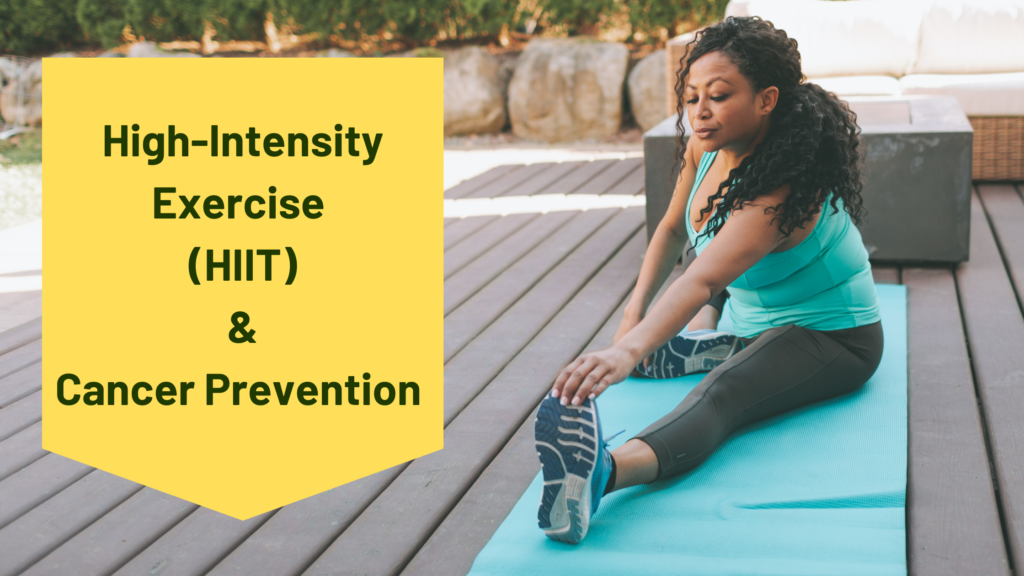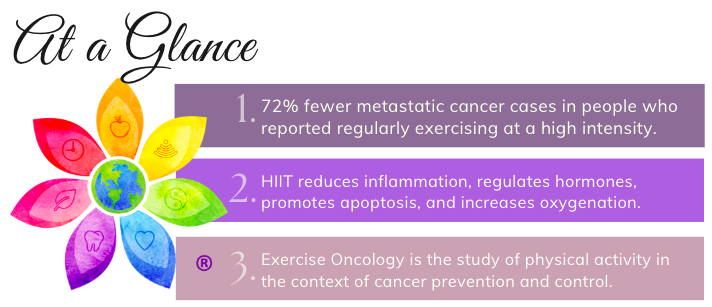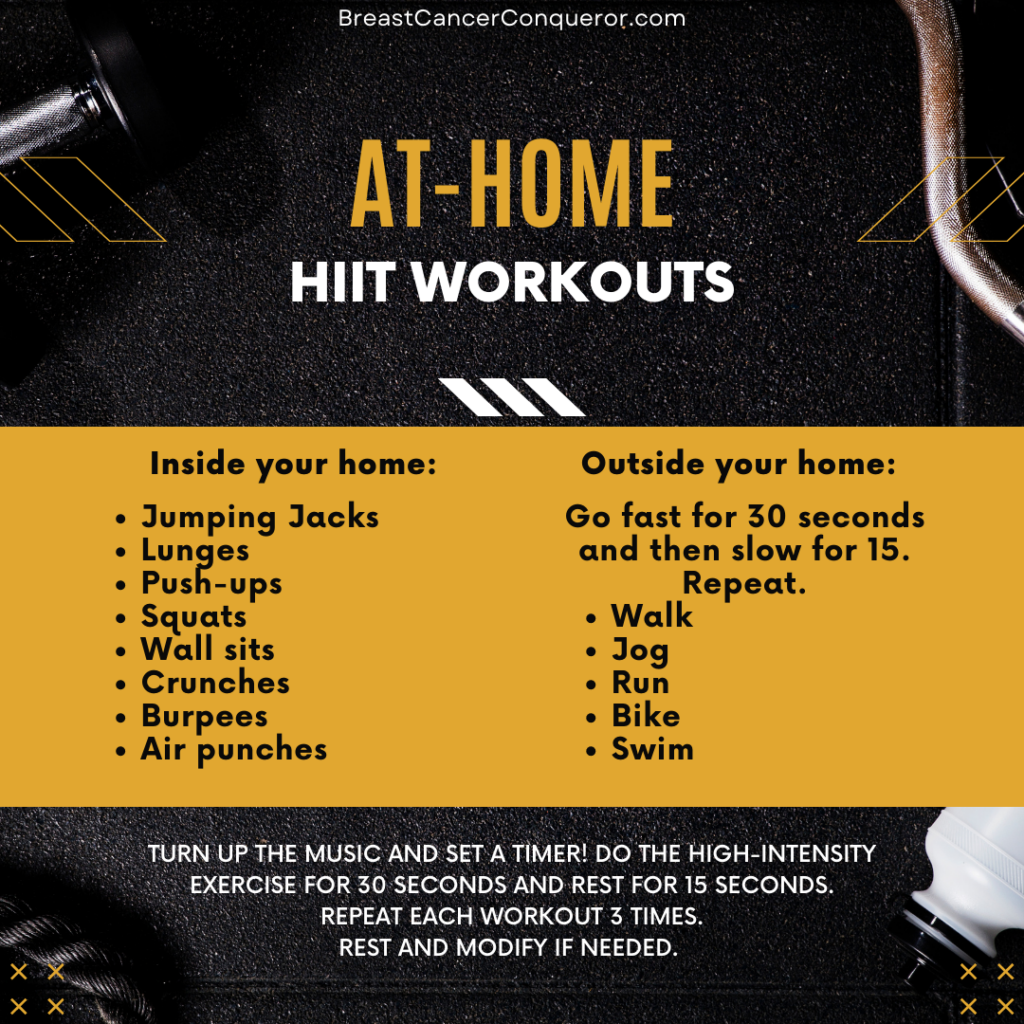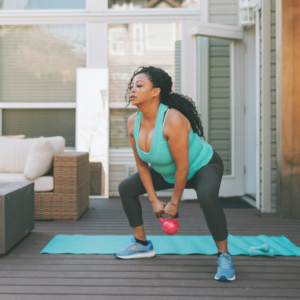

Researchers found that there were 72% fewer metastatic cancer cases in people who reported regularly exercising at a high intensity compared to those who did not engage in physical exercise. 72% FEWER CASES! Ladies, it’s time to live the sweat life to enjoy the sweet, healthy breast life!
Let’s (literally) jump in.
What is HIIT?
HIIT = high-intensity exercise, also known as high-intensity interval training. This type of versatile exercise involves short bursts of intense activity (even 30-90 seconds) followed by periods of rest or lower-intensity activity. In the last few years, you may have noticed new HIIT classes popping up on your gym’s group class calendar thanks to their effectiveness in improving cardiovascular health, promoting fat loss, and increasing athletic performance. Even more interesting, recent research has suggested that high-intensity exercise may have additional benefits for cancer prevention and healing.
Any exercise provides countless benefits: sweating out toxins, flooding your body with happiness hormones, building strong muscles, helping you sleep better, boosting confidence, etc. Specifically, HIIT (or any type of high-intensity interval exercise) can also provide a strong defense against cancer.
Here are a few reasons HIIT should be part of your vibrant health lifestyle.
- Reduction of inflammation: Chronic inflammation is a known risk factor for cancer, and high-intensity exercise has been shown to reduce inflammation in the body. Check out this blog to learn more.
- Regulation of hormones: High-intensity exercise can help regulate hormones such as insulin, estrogen, and testosterone, which can be involved in the development of certain types of cancer. As you are likely well aware, balanced hormones are critical to your healing journey. To learn more, check out this blog post, this podcast episode, and this blog post.
- Promotion of apoptosis: Apoptosis is the process by which damaged or abnormal cells are eliminated from the body. High-intensity exercise has been shown to promote apoptosis in cancer cells, potentially reducing the risk of cancer development.
- Increased oxygenation: High-intensity exercise can improve oxygen uptake and delivery to the body’s tissues, which may help reduce the risk of cancer.

A major reason why I created 7 Essentials System® is to showcase that healing breast cancer and living a vibrantly healthy life is a complete lifestyle change. Just like you need all parts of a puzzle to complete it and see the big picture, there will never be just one thing, pill, biohack, surgery, etc., that instantly heals your body, mind, and soul. Doing high-intensity workouts can be one part of curating a body that doesn’t allow cancer in, but it is still just one critical change.
Change can be scary—and overwhelming. We are creatures of habit. This is why I created the Breast Cancer Conqueror Private Coaching Program. A coach will act as your personal guide and support system throughout your journey. She will provide custom support that is specific to your unique story. To conquer breast cancer, supporting your physical, mental, and emotional health is equally important.
Working It Out: Exercise Oncology
It is marvelous to see cancer research and the medical community expanding its treatment protocols to heal ALL parts of your beautiful body. A tumor doesn’t live on a little island in your body. As the 13th-century Persian Poet Rumi. “You are not a drop in the ocean; you are the ocean in a drop.” Every one of your 100 trillion cells is connected. Not one of them stands alone.
The evolving field of Exercise Oncology is the study of physical activity in the context of cancer prevention and control. It brings together scientists and physiologists to study the effect of physical activity on cancer treatment and prognosis to enhance the quality and length of life of cancer thrivers. For example, a recent study from the Memorial Sloan Kettering Cancer Center found that women with early-stage breast cancer can reduce their risk of long-term heart problems with exercise. One of the leading causes of side effects and early death, for women healing breast cancer, is cardiovascular disease. But it doesn’t have to be that way. Your movement is something you have total control over. The study discovered that the more a woman exercised, the greater her reduction in cardiovascular risk. It also stated that more exercise reduces the negative side effects that conventional cancer treatments can have on the heat.
Details of the study
This study involved 3,000 women with early-stage breast cancer. For nine years, it followed them to study their exercise activities and the incidence of heart failure and heart disease. The researchers found that women who regularly exercised had a much lower risk of both conditions. The more they exercised, the lower their risk.
The results 
- Women who exercised 30 minutes a day, 5 days a week (the minimum national recommendation for all Americans) saw a 21% decrease in cardiovascular disease risk.
- Women who worked out for 1 hour a day, 5 days a week saw a 35% reduction.
- Even those who moved for a half hour a day, three days a week, had a 10% reduction compared with women who weren’t active at all.
Stop Cancer: Sweat Away Glucose
Going back to the first line of this article, high-intensity aerobic exercise can significantly lower the chance of developing metastatic cancer by 72%, according to recent Tel Aviv University research. Glucose plays a leading role in either fueling or preventing the spread of cancer. Cancer thrives on sugar (glucose and glutamine). Therefore exercise and reducing your glucose intake can give you superpowers for stopping cancer. Get all the details via this blog post.
For more proof, here’s what the study uncovered:
“Examining the cells of these organs, we found a rise in the number of glucose receptors during high-intensity aerobic activity—increasing glucose intake and turning the organs into effective energy-consumption machines, very much like the muscles.” This happens because the organs must compete for sugar resources with the muscles, which are known to burn large quantities of glucose during physical exercise. As a result, there is less glucose—therefore energy—available for cancer to metastasize, or grow and spread.
Let’s Get Sweaty!
Anything that gets your moving is exercise. Dancing, hiking, skiing, biking, snowshoeing, swimming, chasing your grandkids around. All exercise. The world, and your living room, can be your gym. Going to HIIT classes at your gym is always a great idea, but if that is not an option, do a class from a YouTube teacher. Just get moving!
